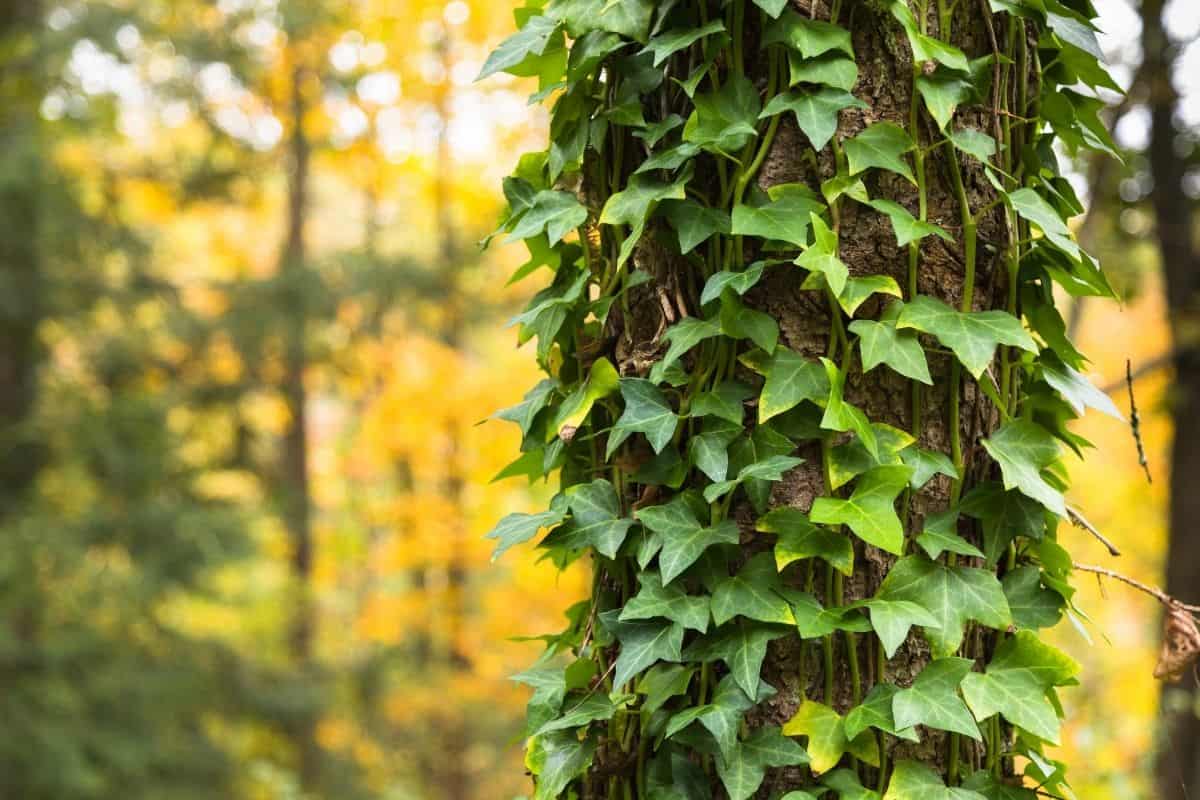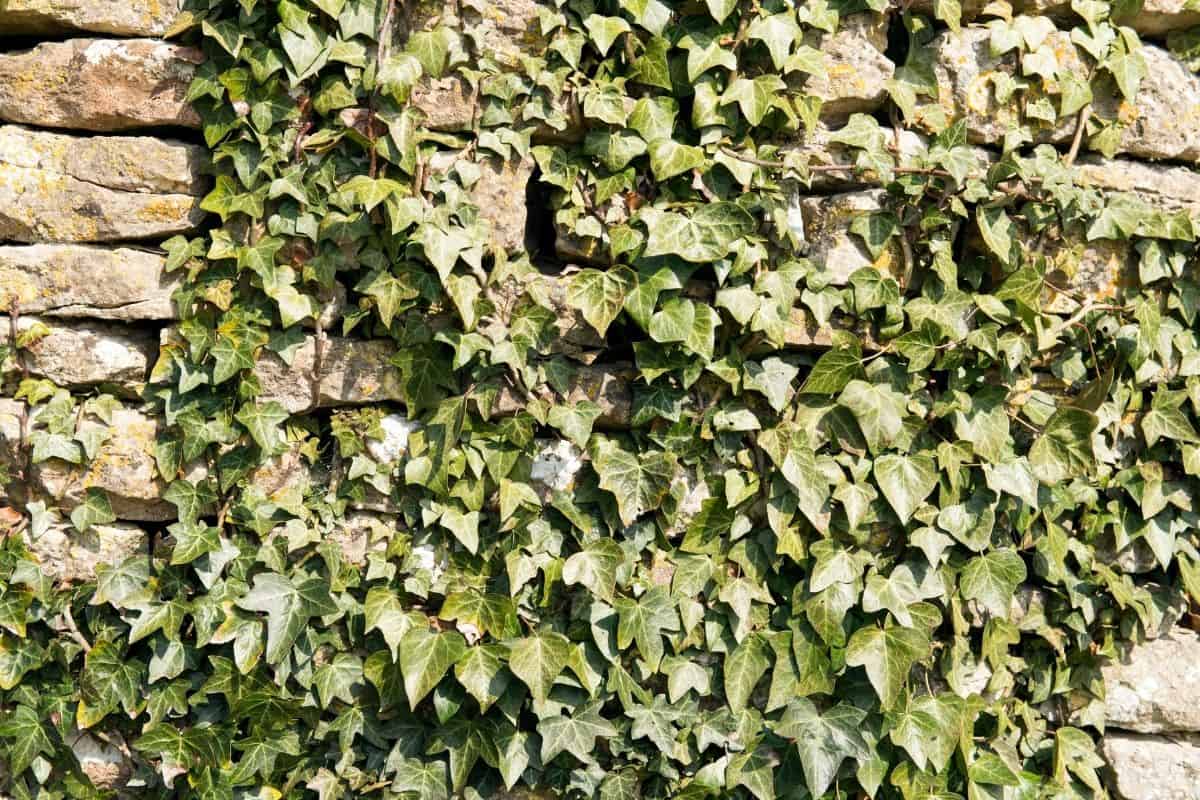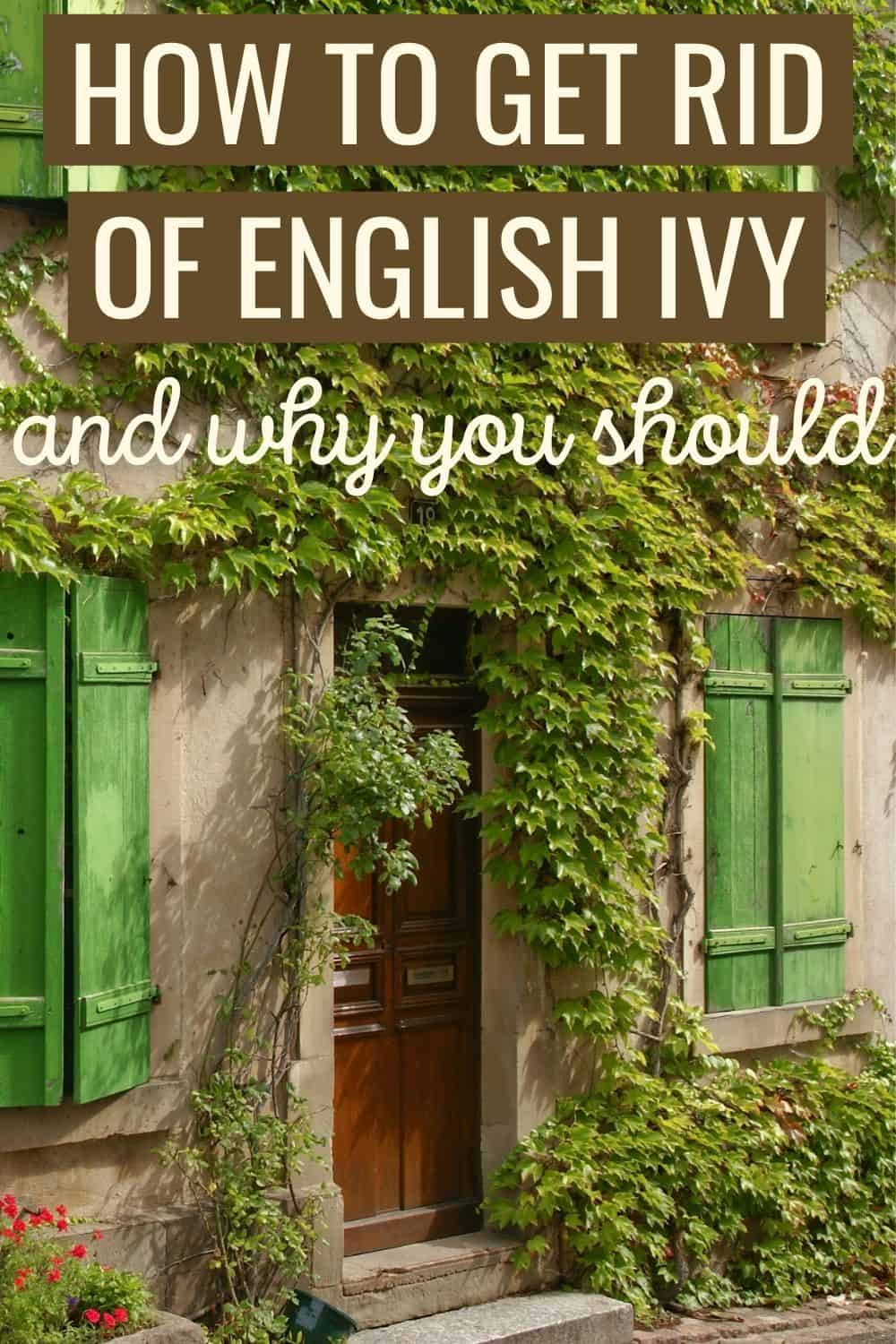Have you ever seen one of those houses covered up in greenery? Many of them are covered in English Ivy (Hedera helix) and they are beautiful! But ivy can easily damage the outside of the house. It attaches itself to the mortar between bricks, to stucco, wood, and even vinyl siding, and will not only slowly insert itself deeper into the walls, but it will hide all kinds of creatures you might not want that close to your windows.
If you wonder how to get rid of English Ivy, we’ll share with you a few methods, so you can choose one that will resonate with you.
There are several ways to get rid of the English Ivy growing in your yard. I always love a natural alternative whenever possible, so my first choice would be white vinegar in a yard sprayer. We’ll explore more options below.

You can eradicate English Ivy by spraying white vinegar on the Ivy vines, but make sure to avoid spraying any on the surrounding plants. After a week has passed, check on the vines you sprayed to verify if they have died. If not, spray on some more vinegar and wait another week. When the vines have all died you can remove and dispose of them.
How To Remove English Ivy From Your Property
What is English Ivy?
A vine that grows rapidly and is capable of creating an invasion wherever it grows, English ivy is known to choke or strangle other types of ground covers and even trees. English Ivy does this by blocking out the sunlight and becoming engrossed with all the plant’s nutrients.
Why should I remove ivy from my yard?
While the leaves of English ivy are shiny and beautiful and might make it desirable to create a ground cover under your trees where nothing else seems to thrive, this plant is very invasive.
Here are just a few reasons you should get rid of it:
- as it grows, it chokes out any other plants it encounters
- its aerial roots attach to tree bark and buildings and it makes itself at home
- when it covers trees, it can prevent them from leafing out, and those trees eventually die
- it will invade neighboring yards
- as the mature vines produce seeds, birds will spread them to other areas
How to get rid of English ivy from trees

When English Ivy grows on trees the vines may form a bridge, allowing the flames of a wildfire or other diseases to quickly spread. Because of this, it is important to remove English Ivy vines from these trees.
You should always make sure to have long sleeves, good shoes, pants, and a pair of sturdy gloves when tasking to remove this Ivy. Although English Ivy isn’t as dangerous as poison ivy, it might irritate the skin it comes in contact with.
The best way to get rid of English Ivy that is growing on trees is to cut off the vine from the ground and let the overhead vines hang until they dry out. This way, you don’t destroy the tree bark, or possibly disturb any birds’ nests or beehives in the process.
Once the vine dries on the tree, you can gently pull it off the tree to remove it and then discard it. If you have a particularly aggressive vine, that is deeply embedded in your tree, use a screwdriver or another strong, flat tool to pry the vine off the tree bark. Be careful not to hurt the tree.
Here’s how to deal with the most unwelcome plants in your garden.
Removing English ivy from house walls

Maybe you loved the look of the ivy on your house, but now you realize it’s time to stop the vine’s spread on your house walls. Or, maybe you just bought a new house that is covered in English ivy and you’d rather see your home’s exterior.
Depending on how much ivy is attached to your walls, it could take an afternoon, or several weeks to remove it. Start by cutting off the vine at the base and digging out the roots.
Make sure you gather all the leaves and roots and place them in a black plastic bag that you tie securely and take to the garbage pile. Never add English ivy roots or leaves to your compost pile, or you risk multiplying it. Any piece of ivy you leave on the ground is a possible new plant.
Then gently pull the skinny vines off your wall. If the ivy vines are old and thick, you need to let the vines die after tyo0u remove their source of nutrients, and then slowly and patiently pull the vines, making sure you don’t damage the wall.
Ways to get rid of English ivy without chemicals
Not every gardener is in favor of using chemical treatments to eradicate pesky plants and weeds. For this reason, we’re sharing some non-chemical ways to abolish the English Ivy in your yard.
Here are some ways for getting rid of English Ivy sans chemical treatments.
- running a lawnmower over the ground where the Ivy grows a couple of times each year will deter growth and eventually kill English Ivy vines
- removing English Ivy by pulling it out of the ground by the roots is a sure way to get rid of it. Just ensure you wear some thick garden gloves. In addition, you can use a trowel to get at those extra-stubborn roots.
- use white vinegar as a homemade English Ivy killer: simply pour some of it into a spray bottle and generously spray all over the Ivy. Just ensure you don’t spray other plants you don’t want to kill with this solution.
When you are trying to eradicate English Ivy vines do not put them on the compost pile. It will re-root itself inside your compost! You need to make sure you completely destroy it, perhaps burning it in a bonfire would be an ideal solution.
Killing English ivy with herbicides
If you want to stay natural, this section might not be for you. But sometimes just pulling the ivy by the roots and dousing it in white vinegar still won’t do it. If you have a huge area or old vines, you might need to use herbicides. One such herbicide is glyphosate, it is one of the most efficient products used when trying to control English Ivy.
When killing English Ivy vines effectively, you need to get past that waxy barrier covering the leaves. The way to do this is to buy an herbicide that will be just as efficient on a cold wintery day as a warm sunny day.
When the weather is cooler, an herbicidal spray will not evaporate as rapidly as when it is warmer. The herbicide can penetrate through the leaves during warm weather because the sun warms the wax coating. You can also cut or slice the stems of English Ivy in your attempt to kill English Ivy permanently.
You can do this using a device similar to a weed whacker to destroy the stems. Afterward, you can put glyphosate on the remaining parts of the Ivy plant and it will kill the plant as it gets deep within the wounds you have inflicted upon the plant.
But, what if I love the look of English Ivy?
It’s understandable to love ivy (its foliage is gorgeous!), and you can enjoy it in your home, as an indoor plant, where it can not take over the year. It works great in hanging baskets!
And fi you love hanging baskets, you need to check out all these indoor plants for hanging baskets.
Frequently Asked Questions
What will kill English Ivy permanently?
There are a number of chemicals or herbicides that will do the job. You need to make sure the herbicide has a blend of triclopyr, glyphosate imazapyr chemicals. These enzymatic agents will attack the roots of the plant to ensure it is killed.
What agents kill English Ivy the best?
Because of the waxiness of the outer part of the leaves of English Ivy, it is hard to kill with herbicides. Yet, glyphosate appears to be the most effective chemical agent at killing this plant.
How can you avert English Ivy from growing back once killed?
The best way to prevent this Ivy from returning is to lay out a barrier.
- Put out some cardboard on the place the Ivy once grew; layer several pieces that overlap. As the cardboard is decomposing into the soil, it also averts the process of the Ivy root re-sprouting.
- Or you can put some jute netting over the entire area.
- Lastly, you can use a landscaping fabric as a barrier for weeds.
Is English Ivy an invasive plant?
Yes. This plant is an extremely invasive plant. English Ivy or Hedera helix is an evergreen, non-native climbing vine. It is known to grow anywhere and will even cover a tree completely, eventually killing causing its demise. When growing on the ground, it will choke out other plants in its way. English Ivy is known to form an “Ivy desert” in which no other plants are allowed to grow where it does.
What if I have English Ivy on bricks and want to remove it?
If you have English Ivy growing on walls or bricks and want to get rid of it we have a few ideas. One way is to use a plastic or wooden tool for scraping away the Ivy leaves and vines. Another way is to spray the surface or bricks with water, using a brush made of nylon to scrub at the vines and leaves. (Just ensure when doing this you don’t harm the surface of your wall or bricks with the bristles of the brush).
Conclusion
As a backyard gardener and a lover of plants, you enjoy the beauty of English Ivy. Yet, when it gets too invasive and starts harming or threatening the rest of your garden you need to eradicate it. You must control the growth of English Ivy so it doesn’t do harm to the rest of your flowers and foliage. We have given you some ideas on how to do this.
From natural alternatives, using supplies straight from the pantry, apple cider, or white vinegar, to the chemical-based methods. You will certainly find one of these ways for getting rid of unwanted English Ivy to be a success.
Once you have eradicated the English Ivy from invading your garden, you will be able to enjoy the natural beauty of it. This plant is a beautiful plant when controlled and kept confined to a particular area. However, it does take time and patience to keep it trimmed and away from other plants.





Virginia Native Plants List: 14 Pretty Blooming Garden Flowers
Thursday 10th of August 2023
[…] how to get rid of the periwinkle vine), multiflora rose, Chinaberry, English ivy (learn how to remove English ivy for good), tall fescue, Russian olive, and Bermuda grass. Take some time to learn about the invasive species […]